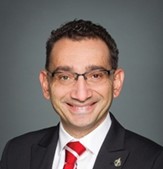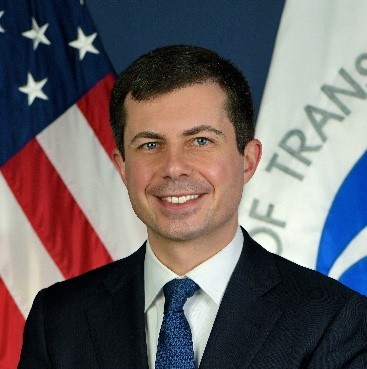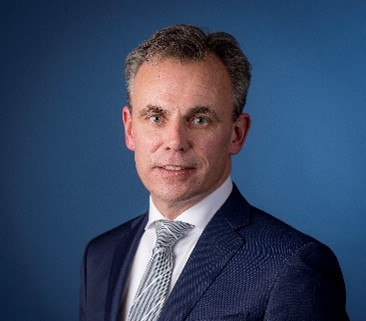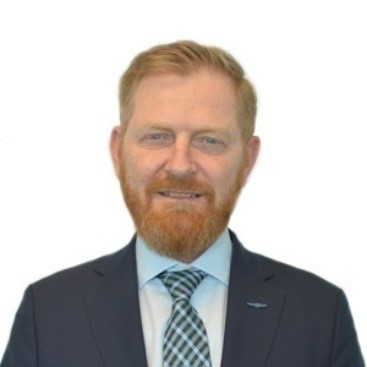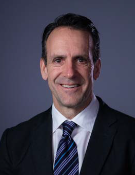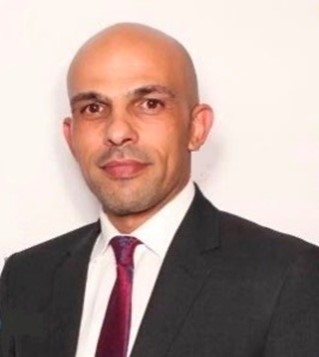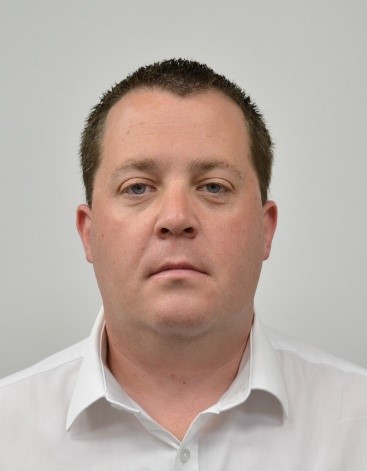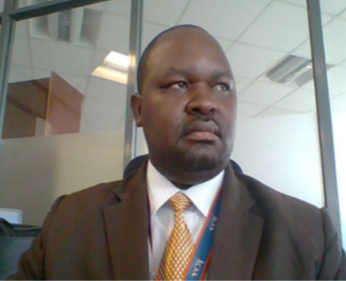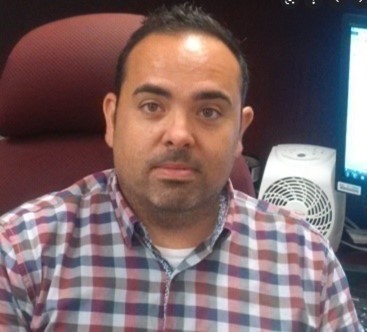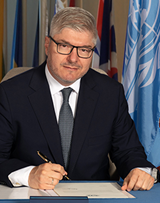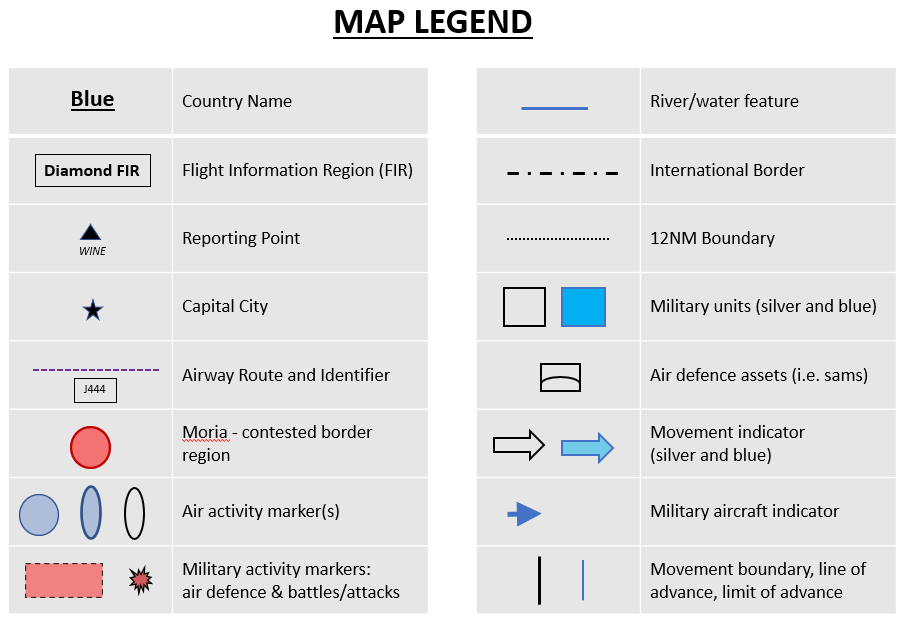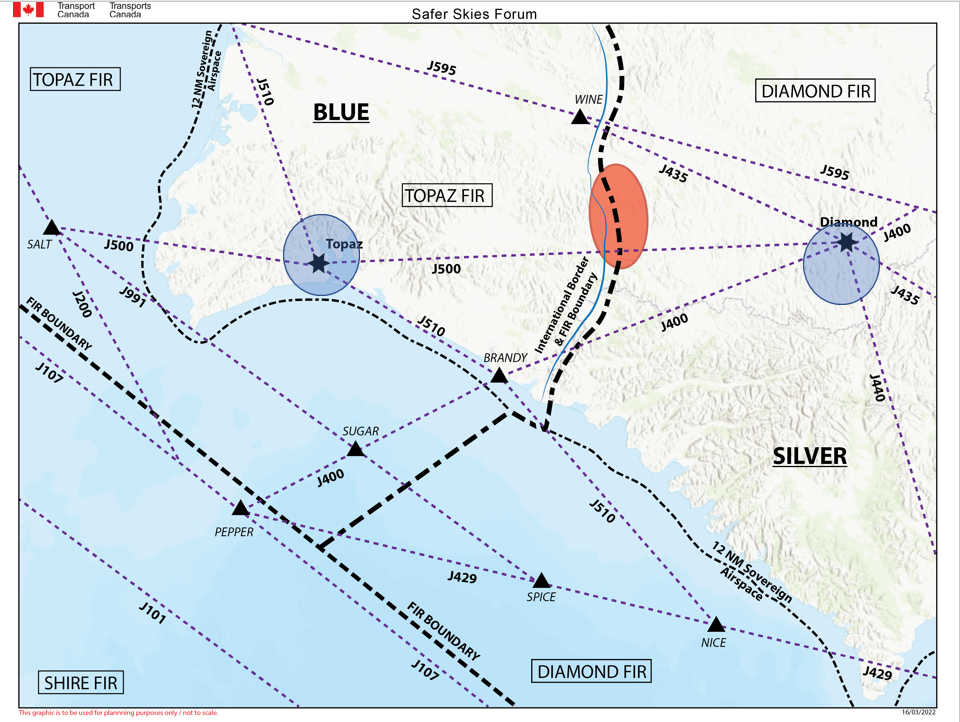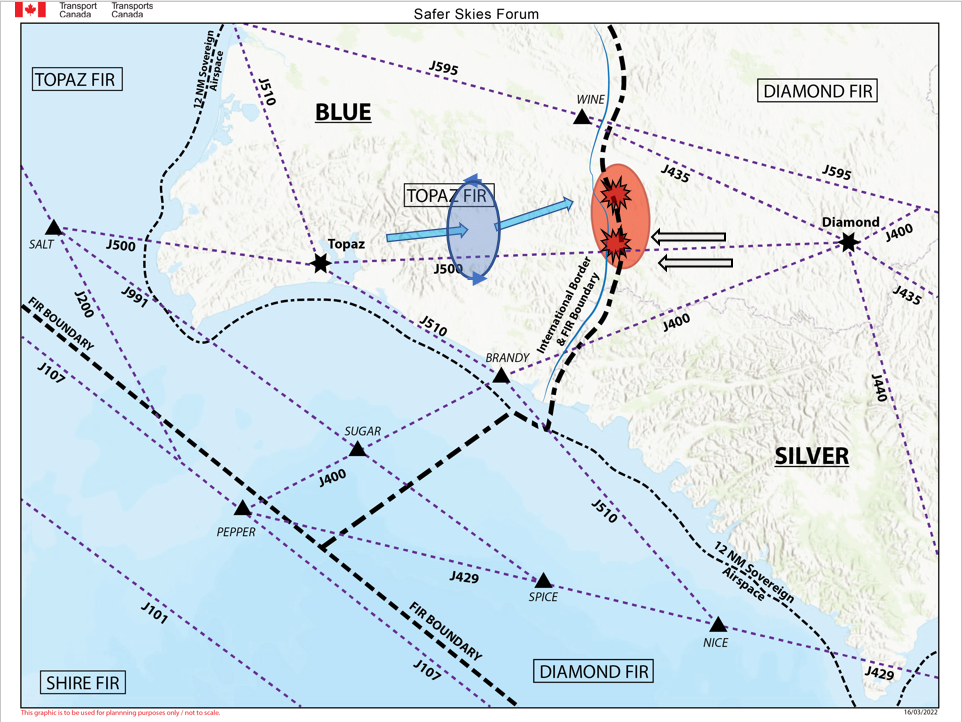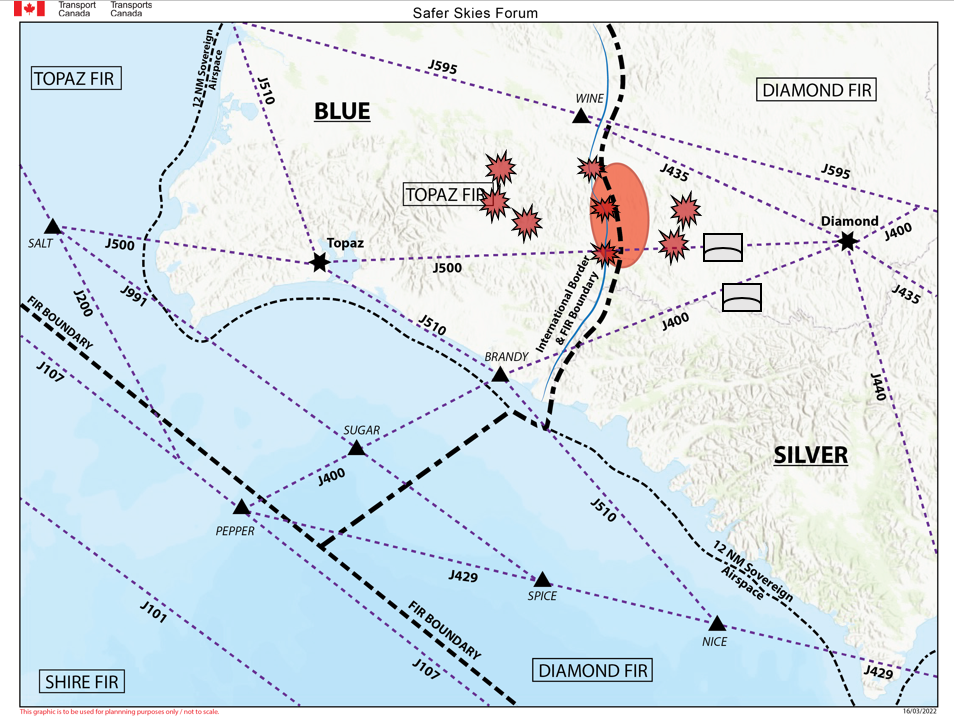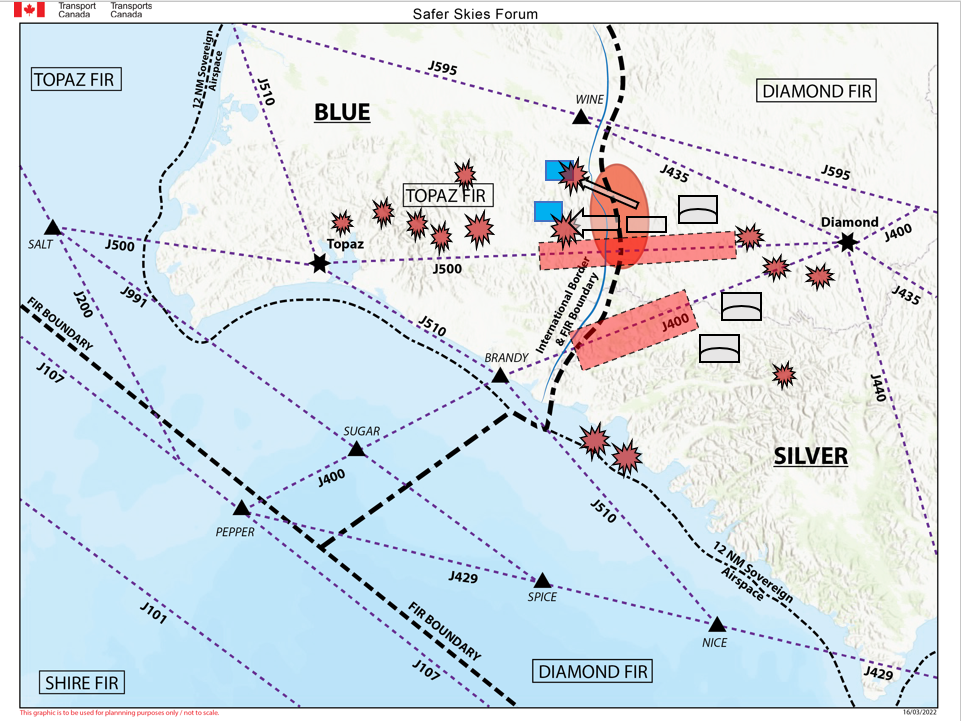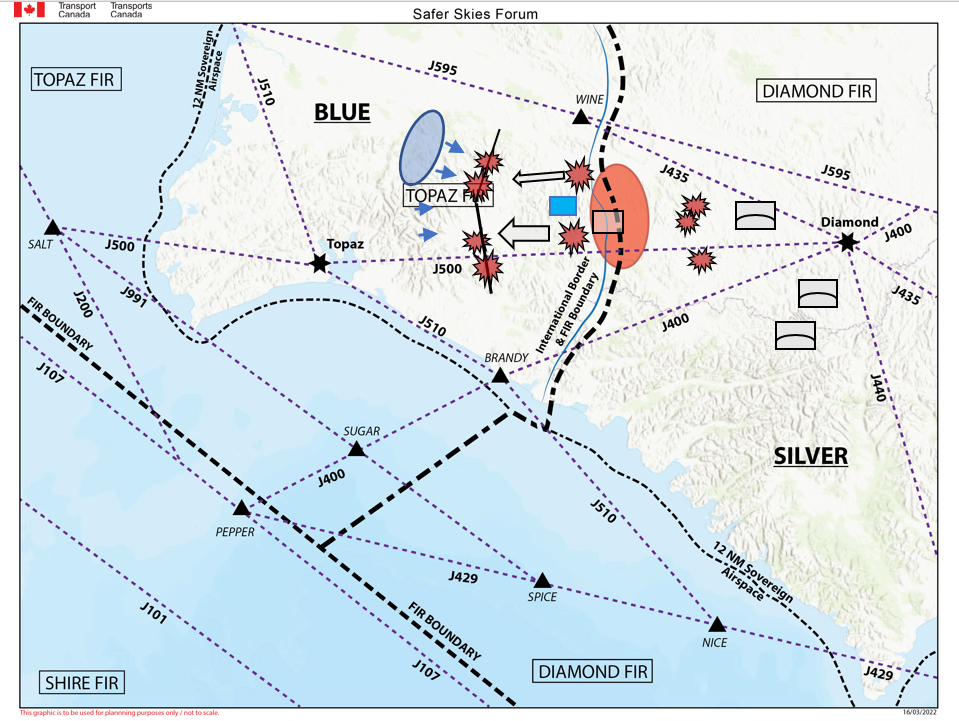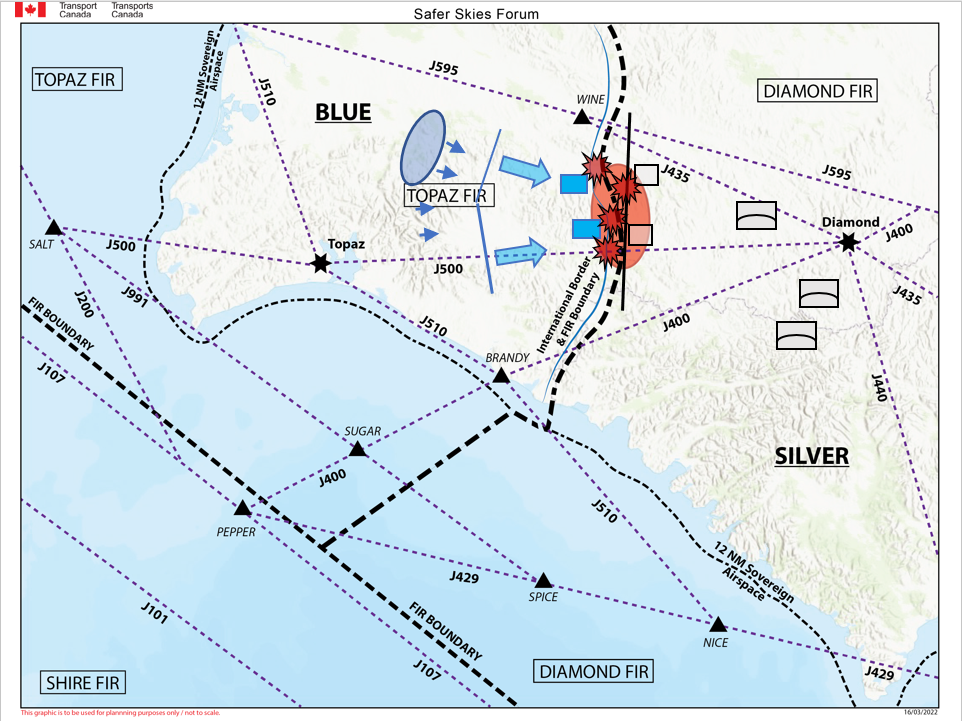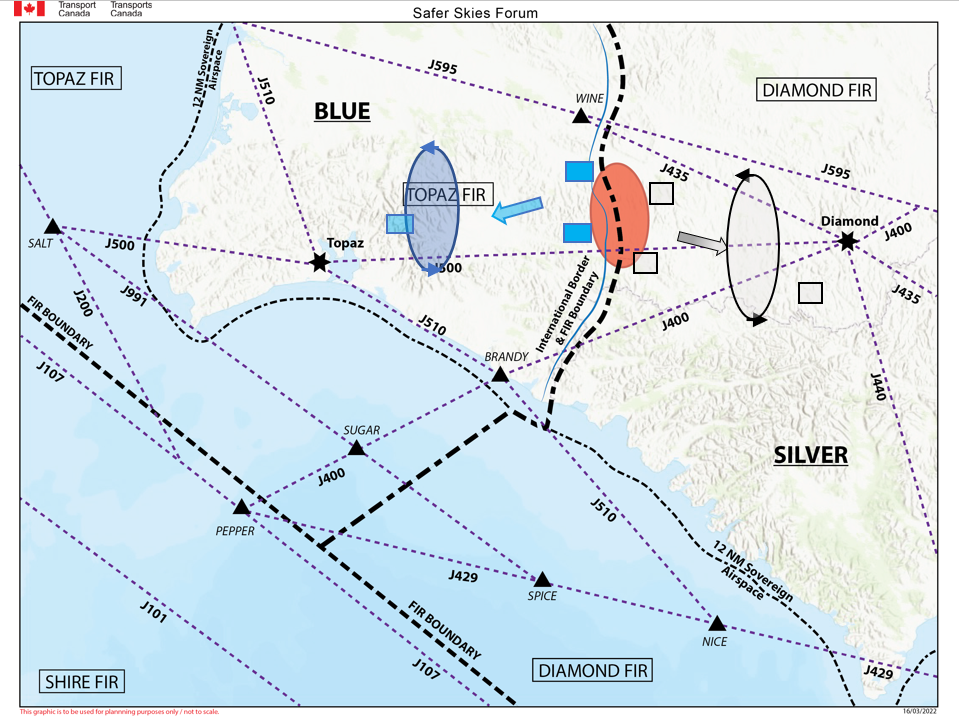March 29 - 30, 2022
Table of Contents
- 1. General Overview
- 2. Summary of content
- 2.1 Session 1: Opening Ceremonies
- 2.2 Session 2: Current Threats and Information Sharing and Introduction of Fictional Scenario
- 2.3 Session 3: Assessing Conflict Zone Risks
- 2.4 Session 4: Identifying and Implementing Risk Mitigation to Address Threat
- 2.5 Session 5: Fictional Scenario Wrap-up – Discussion
- 2.6 Session 6: Closing Session
- 3. Conclusion
- 4. Appendices
Welcome Message
The aviation industry plays a key role in connecting people and places across the planet. However, the vital services it provides are not immune to the safety and security risks posed by armed conflict, as tragically demonstrated by the downing of Malaysian Airlines Flight 17 (MH17) and Ukraine International Airlines Flight 752 (PS752). These tragedies clearly demonstrate the continued need for international cooperation and standardization in how the civil aviation community addresses the risks we all face from conflict zones.
In response to the downing of PS752, Canada established the Safer Skies Initiative. The main objective of the Initiative is to improve the safety of air travel worldwide by addressing gaps in the way the civil aviation sector deals with conflict zones. Building on the important work accomplished by the Netherlands and the International Civil Aviation Organization post MH17, the Safer Skies Initiative aims to enable States to take immediate action to reduce risk, while also promoting improvements to the global aviation system.
The Safer Skies Forum is a place for members of the aviation community to collaborate and share on a variety of topics, best practices and strategies to mitigate conflict zone risk. It brings States, international organizations and industry partners together with a common goal: to establish a common set of principles and practices to better protect passengers from the risk of flying in or near conflict zones.
Transport Canada (TC) and the Safer Skies Consultative Committee thank you for attending the virtual Forum from your offices and homes around the world. Without your support and commitment, the Safer Skies Initiative would not be possible. We also take this opportunity to invite States and organizations to endorse the Safer Skies Statement, which is available on TC’s website.
1. General Overview
1.1 Safer Skies Forum
The Safer Skies Forum is the only global event exclusively dedicated to improving the processes required to manage the shared risks conflict zones pose to global civil aviation operations.
The second Forum brought together States, organizations, and the global civil aviation industry to share expertise on conflict zone risk and engage in discussions focused on the threat environment, lessons learned, and best practices with respect to risk mitigation strategies. The Forum also addressed the way forward for advancing the Safer Skies Initiative and affirmed the international civil aviation community’s commitment to work together to mitigate conflict zone airspace risk.
1.2 Organizers
The Forum was co-hosted by the Government of Canada and the Safer Skies Consultative Committee (SSCC). Transport Canada (TC) would like to express its appreciation to its international partners in the SSCC whose leadership and guidance were integral to the development and delivery of this event.
Canada and the SSCC would also like to thank the many countries and industry stakeholders who agreed to lend their time and expertise as speakers, moderators, and/or panellists.
1.3 Format
The second Forum was a virtual event hosted on March 29 and 30, 2022, via the Engagez online platform. The event was divided into six sessions ranging from 60 to 120 minutes in length, held at various times during the day to ensure maximum global representation. The virtual platform allowed Forum participants to connect with one another in the Social Lounge section and to interact during and after the presentations. Within the Resources section, participants were given access to the documents presented throughout the Forum. For those who could not attend the Forum, or for participants who wanted to watch the presentations and discussions again, all six sessions were available under the ‘’on-demand Sessions’’ section of the platform, until the end of June 2022.
Canada’s Minister of Transport, the Honourable Omar Alghabra, delivered the Forum’s opening remarks, followed by other notable key speakers. Each subsequent session was guided by a moderator and featured expert panellists who spoke about specific topics. The sessions culminated in a question-and-answer period addressing questions that were prepared in advance by the moderator as well as live questions via the chat function posed by Forum participants.
Finally, a fictional conflict scenario was introduced at the beginning of the event and integrated into the content of each session. This provided an opportunity for participants to reference a plausible conflict while discussing best practices in information-sharing, risk assessment approaches and risk mitigation.
The second Safer Skies Forum Agenda and list of speakers is available in Appendix 1.
1.4 Speakers, moderators, and panellists
Day one of the Forum welcomed a group of distinguished keynote speakers, which included the President of the International Civil Aviation Organization (ICAO), the Secretary of Transportation from the United States Department of Transportation, the Secretary of State for Transport of the United Kingdom, the Minister of Infrastructure and Water Management from the Netherlands, the Ambassador of the Republic of Colombia to Canada, the President of the International Federation of Airline Pilots Associations' (IFALPA), and the Chargé d’Affaires of the Embassy of Ukraine in Canada. Speaker biographies are available in Appendix 2.
1.5 Participants
The second-annual Forum brought together more than 366 experts, from 55+ countries including states that are currently experiencing conflict within or near their borders. Participants registered from all parts of the globe including for example, Cameroon, Canada, Dominican Republic, France, Germany, Jordan, Kenya, Latvia, Morocco, the Netherlands, New Zealand, Peru, Republic of Korea, South Korea, Ukraine, United Kingdom (U.K.), and the United States (U.S.), among many others. Attendees represented the breadth and range of experiences and expertise across the global civil aviation community.
2. Summary of content
2.1 Session 1: Opening Ceremonies
The Honourable Omar Alghabra, Canada’s Minister of Transport, delivered the opening remarks welcoming participants to the Second Safer Skies Forum. Following Minister Alghabra’s address, several distinguished guests delivered noteworthy remarks highlighting what has been accomplished thus far while emphasizing the critical reasons why a Forum of this nature continues to be required.
In their words
Governments and airlines have key roles to play in helping to ensure that the risks conflict zones pose to civil aviation do not lead to future loss of life of aircraft passengers and crew.
The U.S. strongly supports the Safer Skies Initiative. To protect our citizens, we must work together.
The work of the Safer Skies has never been more crucial. So, let’s strengthen our global coalition against those who threaten our aircraft, reaffirm the values we share to protect the lives of innocent passengers and crews, and pledge to work together more closely than ever before to keep commercial aviation safe.
No matter which airline they choose, where they board their flight, or what their destination may be, all passengers must be assured that their flight path is a safe one. We owe this to all our citizens, all around the world.
It is essential to improve international efforts to safeguard civilian flight operations and to prevent tragedies in air operations.
In the ideal world it shouldn’t be necessary to have these kinds of conferences, but recent times... have shown us that this is more important than ever.
The Safer Skies Initiative, its platforms and forums contribute valuable content to achieve the declared goals, which is safety of air travel worldwide.
2.2 Session 2: Current Threats and Information Sharing and Introduction of Fictional Scenario
The second session focused on the current threat picture and included a discussion concerning the opportunities and challenges faced by states and industry when collecting and sharing information. This included information-sharing between states and industry, and amongst industry itself.
The second part of the session was dedicated to introducing a fictional conflict scenario to serve as a learning tool for participants, as well as for illustrative purposes when discussing various approaches to conducting risk assessments, determining the level of risk, and identifying risk mitigations. Questions from participants were addressed at the end of the session.
Summary of Presentations and Discussion
Current Threats
Expert panellists from the U.S. and Switzerland, along with Osprey Flight Solutions and Dragonfly -industry vendors that provide aviation risk assessments and information- provided an overview of the current threats posed by conflict zones. The U.S. highlighted current geographical areas of concern, including Afghanistan, Ethiopia, Iran, Iraq, North Korea, Syria, Russia, Ukraine, and Yemen. They characterized associated non-state actors operating in these regions as militant groups (e.g., Tigray Defense Forces, Houthis etc.), extremist/terrorist groups (e.g., Islamic State of Iraq and Syria, Al Qaeda and Lebanese Hezbollah), or drug trafficking organizations, and explained that non-state actors can be motivated by several factors including overthrowing the government, taking control of a particular region and/or instilling terror. These groups become a threat when they take action to achieve their goals, which can result in direct, indirect or accidental threats. For example, during the 2020 conflict in Libya, Unmanned Aircraft Systems (UAS) were misidentified by their own operators and accidently shot down, contributing to the heightened threat environment.
The session panellists conveyed that in addition to the primary threat, it is also vital to monitor the potential for spillover. To illustrate, in the context of the Russian invasion of Ukraine, panellists spoke about how European states are closely monitoring the risk of the war rapidly expanding to other European countries. In another example from the war, panellists discussed several recent cases of unidentified UAS entering European airspace, one of which crossed several borders before running out of fuel and crashing. Weapon systems that are not contained by national borders have the potential to trigger escalation, thus posing risk, even when the incursion is unintentional. Incursions can force the re-routing of flights and cause a ‘bottle neck’ between flight routes, which is a spillover safety and security issue. Panellists also noted that while mitigating one risk, another can be created if there is a lack of awareness and communication between relevant parties.
The panel asserted that a key element to effectively mitigating global conflict zone risk is to identify and monitor where civil flight operations and threat intersect. For example, in Iraq and Saudi Arabia, air carriers overfly the region daily. This needs to be actively managed so that risk assessment determinations can be continually updated.
Panellists stressed that a key component in identifying threat is determining capability. Threat actors have access to a variety of weapons and have varying capabilities to employ these weapons. Expert panellists categorized the types of attacks as follows:
- Kinetic Attacks:
- Ground based/low altitude weapons: small arms, heavy machine guns, anti-tank guided missiles, artillery, rockets, mortars, UAS
- Anti-aircraft systems: MANPADS, surface-to-air missile
- Harassing Techniques:
- Global Positioning System/electromagnetic interference
- LasingFootnote 1
- Cyber Attacks:
- Cyber-attacks degrading and/or disrupting aviation-related networks; primarily ransomware.
Trends in capability have been observed regarding aviation safety and security. This includes evident growth in state and non-state actors’ access to more advanced weapons, an increase in UAS procurement, technological development and use, as well as an increase in access to advanced rocket and missile systems by state sponsored groups. In addition, adversaries seek to learn and improve their performance, which can heighten the risk to civil aviation. These trends demonstrate the continued growth of future threats to civil aviation, which can intentionally or unintentionally expose aircraft/passengers to conflict zone risk.
Information-sharing
Panel experts agreed that there has been a significant improvement in civil aviation information sharing program/platforms amongst international partners; however, challenges remain. Advancing information- sharing practices requires an effective communication framework and sufficient resources to implement the necessary updates. To be successful, collaboration and active participation by airlines, states and international associations is necessary.
Panellists identified two opportunities for future work:
- Industry crossover: historically, there has been a reluctance from air carriers to share information with other carriers due to proprietary concerns. These tensions are decreasing and there is now room to develop ‘crossover’ work within industry and the security sector. For carriers, strengthening this network could safeguard their own company, as well as others.
- Government relationship building: governments continue to rely on personality-based information sharing mechanisms through the building of relationships and a network of trust that allows for information exchange on a one-on-one basis. However, there is room to look beyond personal contacts and formalize agency-to-agency processes so that information can be shared holistically; this only works if collaborators are receptive to the information.
It was noted that when sharing information, as a community, we should think about the conflict zone situation in question more broadly, not solely in terms of direct threats to civil aviation. The community needs to consider the situational environment around escalation, and then share the information widely.
In terms of frequency, it was recognized that there is a need to determine how much and how often information should be shared to avoid information overload, which can make information gathering difficult.
Introduction of the Fictional Threat Scenario
The second part of this session was dedicated to the introduction of the fictional conflict scenario. A comprehensive ‘beginning to end’ narrative was provided, outlining the scenario in four distinct phases:
- Pre-conflict – Baselines and Triggers
- Initial Conflict – Assessing Conflict Zone Risks
- Conflict Intensifies – Risk Mitigations
- Situation Stabilizes – Return to Regular Airspace
Although the scenario was fictional, the details were closely aligned with how a real-life conflict zone could develop. The full scenario is available in Appendix 3.
2.3 Session 3: Assessing Conflict Zone Risks
The objective of this session was to identify, highlight and discuss a variety of risk assessment models successfully used within different operational contexts. Panellists from Jordan, New Zealand and Lufthansa Airlines discussed their experiences with various risk assessment methodologies and participated in a fulsome discussion about the challenges, successes and application of each concept.
Summary of Discussion
Assessing Conflict Zone Risk
Discussions underlined the importance of a standardized approach to risk assessment that is designed to maintain open lines of communication between states and industry at all stages of the process. Consistent with discussions that took place during Session Two, panellists highlighted the need to better communicate information in a timely manner (i.e., prioritizing networking and ensuring that information reaches the right people). They also noted that the efficacy of the risk assessment could be optimized if partnerships between states and industry were formalized and based on collaborative information/data collection and assessment.
While State representatives agreed that it is imperative to collaborate when creating mitigation measures for escalating conflicts, they noted that the approach to collaboration varies. Some states’ expectation is for air carriers to provide their assessments as a baseline, with the government making the final decision, if needed. Other states actively support more of a relationship building approach, working directly with the air carriers and permitting specific industry officials to hold national security clearance to allow for more frank and open discussions.
From the air carrier perspective, the importance of establishing and using clear and consistent language when generating and conveying airspace notifications was emphasized. It was noted that pilots should be part of the security team when it comes to conducting risk assessments and should be educated and aware of current issues. The panellist stated that by virtue of their lawful responsibilities, pilots should have the ultimate say on what to do when a risk is identified during a flight. In closing, it was noted that assessments should not be made in isolation, and that generic reactive flight prohibitions should be avoided.
Fictional Scenario
In discussing risk assessments in the context of the fictional scenario, it was pointed out that due to the historic conflict over the border region an airline would likely have a long-standing, no fly zone over the contested area. Notwithstanding that possibility, at this stage an operator would begin by asking, ‘how does this affect us? ‘Do we operate flights in that region’? If the volatile states in question are destinations served by the air carrier, some states would enact a ‘whole-of-government’ approach and include input from departments of foreign affairs regarding engagement between states. It was agreed that information guiding the assessment should be processed through both intelligence and military experts to better understand the intent of those on the ground in the conflict, and their capabilities. Considering the scope of the conflict in its entirety, states may begin to develop an evacuation plan for citizens.
While state and industry perspectives may differ in some respects, it was agreed that risk is a part of aviation and it is up to industry and government to determine acceptable levels of risk, including when it should be accepted, avoided or mitigated.
2.4 Session 4: Identifying and Implementing Risk Mitigation to Address Threat
The focus of Session Four was how states and industry can identify and implement risk mitigations. Panellists from Kenya, Morocco and the United Kingdom (U.K.) presented an overview of how each of their respective states identify risk and the various mitigations available to them when addressing threat.
Summary of Presentations
Due to its important role in the risk mitigation process, information-sharing was referenced by each of the panellists. All three states demonstrated a continued commitment to improving information-sharing with industry, air carriers and service providers. The International Air Transport Association (IATA) was mentioned as a key partner in gaining access to critical data that supports decision making. For example, a technical committee established between Kenya and IATA has enabled the state to have access to valuable information that extends beyond the Eastern African region.
Risk Mitigation
Clearly understanding what you are trying to accomplish in applying risk mitigations is a good first step. Panellists agreed that even though safety and security risk assessments are different in nature, they should be considered concurrently, and free of political considerations. Operational information should also be considered essential to build a full ‘picture’ of the situation before any decision is made.
When determining which mitigation measure(s) should be taken, consequences must be weighed, as often effective mitigation measures can cause indirect ‘spillover’ issues. For example:
- Re-routing flights or restricting airspace results in additional traffic in other air corridors; safety implications must then be assessed.
- Requiring an aircraft to operate at a higher altitude over a conflict zone results in increased fuel consumption affecting the weight of the aircraft and added cost to the airline.
Legislative frameworks and regulating airspace are one potential approach in the risk mitigation decision making processes. When it is deemed necessary in the public interest, some States have the legal authority to restrict operations in a specific airspace, either temporarily or permanently.
For example, in Kenya, risk assessments are conducted by both the state and the national air operator, and while the sate provides advice on potential risks (severity assessment), it is the national operator who ultimately makes decisions for the safe conduct of their operations. Prohibiting flights is considered a last resort.
In general, striking a balance between safety, security, and the impacts of restricting aviation operations is challenging. Panellists emphasized that in addition to legislative authorities (e.g., to issue NOTAMs), what is equally important is the wider set of collaborative tools, including following ICAO annexes and guidance and maintaining robust lines of communication between government and all stakeholders.
When asked if the aviation community is agile enough to respond to threats, panellists agreed that there is always room for improvement, but that due diligence should not be sacrificed for expediency. Timing depends on many things including affected airspace, weaponry, diplomatic relations, and trade implications, to name a few. If an assessment results in a significant effect on any one of these factors, it could take longer to make and subsequently execute a decision. To counterbalance speed with the numerous factors in play, states require resources and both national and international cooperation.
Reflections on Industry Engagement
Coordination is key to engaging with industry. An integrated information management system is needed for governments and industry so that joint data can be assessed, verified, and disseminated to stakeholders in a timely manner. The U.K. has recently formalized a process for rapid information engagement with government, intelligence partners and industry stakeholders. This is a mechanism that government or industry stakeholders can use at any time to share information.
Morocco is currently part of EUROCONTROL’s Air Traffic Management (ATM) Security Coordination Group and is working to establish its own group of security and safety aviation partners within Morocco to share information on conflict zones. Currently Moroccan airlines conduct their own risk assessments; however, the Moroccan state is looking to bring together the efforts from the international community (e.g., EUROCONTROL, IATA, ICAO), with the best practices from the airlines within this unique group.
In discussing best practices for the identification and implementation of mitigation measures, panellists emphasized that coordinated efforts are essential at the national and international level. The way in which stakeholders collaborate is most effective when the processes are formalized. Avoiding the status quo and continuing to be innovative can be achieved by continuously updating procedures and refining processes.
2.5 Session 5: Fictional Scenario Wrap-up – Discussion
Session Five was an opportunity for the moderator and expert panellists from France, IATA, Jordan, Kenya, the Republic of Korea and the U.S. to summarize the results of the discussions surrounding the fictional scenario.
Pre-Conflict
Panellists agreed that the fictional scenario used throughout the Forum was plausible. Many real-life conflicts can initially appear peaceful on the surface. As such, it is important to have an awareness of the pre-conflict or baseline conditions to accurately assess changes. An effective way to monitor risk is to focus on increasing rhetoric from both parties; paying close attention to regional media is one effective way to understand the local situation.
Initial Conflict – Assessing the Conflict Zone
In the fictional scenario, the conflict was initiated with cross-border clashes. When conducting a risk assessment in the initial stage of conflict, it is critical to be aware of the potential triggers that can contribute to the outbreak of violence or further escalate tensions. For example, a subtle change in military posture can signal the need for heightened monitoring and the potential need to plan for alternative routings.
Several other elements were noted as key considerations for the assessment:
- Assess capabilities: understanding the military capabilities of each country. Military and civil aviation collaboration is needed to best understand weaponry and combat strategy.
- Conduct a broad assessment of whole region: are specific areas safer than others?
- Identify threats at various altitudes and refine knowledge of specific routes that are safe.
- Concentrate on the overfly zones and consider high seas as areas that might not have satellite coverage.
- Compare data and observations between states.
- Repatriation flights also require special consideration.
Recognizing that information-sharing is an ICAO Annex 17 obligation, the panel discussed best practices used by their respective organizations in sharing information. It was agreed that relevant and timely information is critical for both open-source and protected information. Open-source data should be validated and shared through formalized channels between government and industry so that carriers may make decisions quickly. However, since the sheer volume of open-source information can be overwhelming, data is best shared when tailored to the audience. Large carriers can handle a substantial volume of information whereas small-scale carriers may better manage critical and verified information.
Panellists noted that maintaining the integrity of a state’s confidentiality laws while sharing relevant classified information with stakeholders is a prevalent concern without a clear-cut, one size fits all solution. However, if classified information cannot be shared, states can, at minimum, communicate that their actions are based on substantiated intelligence.
Conflict Intensifies
States and air carriers have their own risk assessment capabilities, the results of which will often differ. Panellists were asked to comment on whether the state or air carriers’ assessment should take precedence when parties come to different conclusions. One perspective was that the government’s results should be given precedence as airlines tend to be driven by economic considerations. Conversely, it was suggested that the carrier’s findings should be given precedence when it comes to purely safety assessments within conflict zones since that is their domain, and that government assessments should be given precedent for general security-related threats. Panellists recommended that rather than being reactive to changes in the situation, the precautionary principleFootnote 2 should be applied each time.
Situation Stabilizes
Panellists identified indicators that pointed to the situation stabilizing:
- States have exhausted their capability and will to continue fighting. The international community-imposed sanctions preventing further large-scale aggression. External material supports were depleted and there was a lack of public support for the current conflict.
- The local population pressured their leadership to agree to a ceasefire.
- Cross-border activity ceased but tensions remain elevated. While there is an absence of heavy weapons fire, local commanders remained in place and a defensive footing is established. There remains a show of force and heightened vigilance; there is potential for localized skirmishes, but actions and responses were small scale in nature.
- Conditions have begun to stabilize to enable decisions to restore civil operations in areas of the conflict-associated restricted airspace. There is an outright return to bases by military and/or local leaders and government officials are establishing contact directly, or through supporting states.
Despite stabilization, expert panellists recommended that states continue to monitor the situation for a period of time in case of ceasefire violations. One way to be assured that states experiencing conflict are trustworthy with their peace rhetoric is to monitor their land activity to determine if their physical stance matches their verbal assertions. A gradual process of lifting risk mitigations was preferred by the expert panellists rather than easing all restrictions at once. Of note, scaling back a NOTAM/AIC is equally important as the initial implementation and the repetition of a full-scale risk assessment is required prior to any NOTAM revision.
Attendees were encouraged to take the scenario back to colleagues and conduct their own assessment. Questions that could be posed include: (1) Do we have the right procedures and communications processes in place; (2) What is our inventory of mitigation measures? The documents produced by the SSCC can be used to support this process.
2.6 Session 6: Closing Session
The closing session, moderated by Mr. Kevin Brosseau, Assistant Deputy Minister at Transport Canada, highlighted opportunities for action by the international civil aviation community identified throughout the Forum. It brought together representatives from the European Civil Aviation Conference (ECAC), Expert Group on Risk Information Overflying Conflict Zones (EGRICZ), IATA and the SSCC.
The Secretary General of ICAO, H.E. Juan Carlos Salazar opened the session and provided remarks that highlighted the Safer Skies Forum and noting that it will be imperative for the international community to maintain the momentum that has been created. As demonstrated in the current context of the Russian invasion in Ukraine, there have been significant improvements in the development and efficacy of conflict zone risk management. However, as H.E. Salazar pointed out, risk comes in many forms with most conflicts being unpredictable and hard to manage. For this reason, ICAO’s Air Navigation Commission recently authorized the establishment of a new integrated Risk Management Study Group. This body of experts will review related risk management methodologies from the perspective of each of ICAO’s strategic objectives. The goal is to determine the feasibility of a unified framework that can be adapted and applied at both state and service provider levels.
Following H.E. Salazar’s remarks, Mr. Brosseau asked the panel what their respective organization’s plans were to address and enhance responses to conflict zones airspace risk management in the next year, and in the longer term.
ECAC – as a coordinator and ‘think-tank’ for its member states, ECAC is committed to initiatives that innovate and improve information sharing methods to help members to be ready for the ‘next unexpected situation’. Future work will focus on identifying remaining gaps and how to address them. There is space for a range of approaches, and ECAC will continue to work with industry, states and commercial organizations to support open-source information sharing.
EGRICZ – the priority will be on strengthening existing global conflict zone guidance documents. EGRICZ would like to see ICAO Doc 10084 strengthened through the inclusion of several best practices it has developed over the past few years.
IATA – getting information in the right hands at the right time is fundamental. IATA’s focus for the next year will be to continue taking advice from regulators and airlines and leveraging their digital platform to address information requirements.
SSCC – tackling the challenges associated with information sharing is of the utmost importance. The SSCC is identifying and evaluating international initiatives for rapid information-sharing pertaining to overflight threats and vulnerabilities in international civilian operations. Additionally, the SSCC will look to enhance its leadership within the global civil aviation community by establishing a formal State to State mentorship framework that will ensure conflict zone risk mitigation capacity is develop around the world.
3. Conclusion
3.1 Next Steps
The Second Safer Skies Forum, organized in part by the SSCC, presented an excellent opportunity for global civil aviation authorities, industry, and conflict zone risk mitigation subject-matter experts to come together to share their knowledge. In discussing the way forward, panellists were united in the understanding that due to the nature of conflict zone risk management, a deliverable is never truly ‘complete’; the work is continually evolving.
Collectively, it was conveyed that next steps will focus on more tangible elements e.g., what does information-sharing mean? How do we measure it? In advancing this approach it was indicated that it will be important to obtain advice from regulators and air operators and leveraging a digital platform using public information as a baseline.
Panellists agreed that the importance of wide representation, including a diversity of perspectives, is an essential component of achieving Safer Skies. Safer Skies has engaged with a significant number of states; however, as we move forward it is important to ensure the remaining gaps are filled. Conflict zone risk does not ‘set apart’ nationality of the overflying aircraft, therefore, best practices need to be disseminated as broadly as possible beyond SSCC member countries. This can be accomplished by making use of ICAO assemblies; it was also suggested that NATO be included in this work through a collaboration with ICAO and to incorporate unconventional actors into discussions (such as military representatives) acknowledging, that this could be sensitive in practice.
The third-annual Safer Skies Forum will be held in-person if it is safe to do so. A live-stream option will also be available enabling those who cannot travel to fully participate. The Netherlands, in collaboration with Canada, will host the third iteration of the event in 2023.
4. Appendices
4.1 The Safer Skies Forum Agenda
4.2 The Safer Skies Forum Biographies
4.4 Safer Skies Consultative Committee Documents
4.1 The Safer Skies Forum Agenda
-
Tuesday, March 29th, 2022
Session one - Opening Ceremonies
11:00 Z - 12:30 Z
Speakers:
Honourable Omar Alghabra – Minister of Transport of Canada
H.E. Salvatore Sciacchitano – President of the Council, International Civil Aviation Organization (ICAO)
Secretary Pete Buttigieg, Secretary of Transportation, U.S. Department of Transportation
Rt. Hon. Grant Shapps, Secretary of State for Transport of the United Kingdom
Honourable Mark Harbers, Minister of Infrastructure and Water Management, Netherlands
H.E Jorge Londoño de la Cuesta, Ambassador of the Republic of Colombia to Canada, Colombia
Captain Jack Netskar, President, International Federation of Air Line Pilots' Associations (IFALPA)
Special Guest: Andrii Bukvych, Chargé d’Affaires of the Embassy of Ukraine in Canada
Master of Ceremonies: Kevin Brosseau, Assistant Deputy Minister, Safety and Security, Transport Canada
Session two - Information Sharing
13:00 Z - 14:45 Z Current Threats and Information Sharing
This session will provide participants with an update of the current threat picture, as well as a discussion of the opportunities and challenges faced by states and industry in collecting and sharing information, including intelligence. This includes information sharing between states and industry, and amongst industry. Further questions to be addressed include: What kind of framework is needed to support information sharing? And how do we ensure that enough resources are available to efficiently implement information sharing practices?
Moderator: John A. Anderson, Manager of the Threat and Analysis Division, Office of National Security Programs and Incident Response, Federal Aviation Administration (FAA), USA & Member of the Safer Skies Consultative Committee
Expert Panel:
Matthew Borie, Chief Intelligence Officer, Osprey Flight Solutions
Carole Geissman, Legal and International Affairs at Federal Office of Civil Aviation, Switzerland
Joel Gulhane, Senior Associate, Dragonfly
Christy Hickey, Senior Analyst, Threat Analysis Division, Federal Aviation Administration (FAA) or,
William Muldoon, Senior Analyst, Threat Analysis Division, Federal Aviation Administration (FAA), USA & Member of the Safer Skies Consultative Committee
15:00 Z - 16:00 Z Introduction to Fictional Scenario
A fictional scenario will be introduced to participants. The panel of experts will discuss best practices in terms of obtaining information (intelligence and open source) and sharing information between states, and states to industry. A Question & Answer session will follow.
Presenter: Arnaud Borde, Head of Risk Analysis Unit for Civil Aviation, Directorate General for Civil Aviation, France & Member of the Safer Skies Consultative Committee
Session three - Risk Assessment
17:00 Z - 19:00 Z Assessing Conflict Risk Zones
Panellists will highlight and discuss different risk assessment models successfully used in different contexts (e.g., smaller versus larger states, passenger carriers versus cargo carriers). This session will allow for robust discussion with participants to clarify concepts and application.
Leveraging the fictional scenario, the panel will highlight how to conduct the risk assessment, and what the determination of risk would be. A Question & Answer session to follow.
Moderator: Nicholas Robinson, Director General, Civil Aviation, Transport Canada
Expert Panel:
Abdulla A. Al-Nsour, Director of AVSEC & Facilitation, Aviation Security & Facilitation Directorate, Jordan Civil Aviation Regulatory Commission
Mike Hill, Deputy Chief Executive Aviation Security and Infrastructure for the Civil Aviation Authority of New Zealand & Member of the Safer Skies Consultative Committee
Katharina Hemming, Aviation Security Risk Manager, Lufthansa Airlines
-
Wednesday, March 30th, 2022
Session four - Risk Mitigations
11:00 Z - 12:30 Z Identifying and Implementing Risk Mitigations to Address Threats
This session will present the results of the fictional scenario up to that point and introduce the notion of risk mitigation.
Panellists will highlight best practices and present various approaches, which will then be applied to the fictional scenario. A Question & Answer session will follow.
Moderator: Sarah Nacey, Deputy Director, Aviation Security Strategy & Policy, Department for Transport, United Kingdom
Expert Panel:
Richard Cave, Head of Global Risk & Response, Aviation Security, Strategy & Policy (ASSP), Department for Transport, United Kingdom & Member of the Safer Skies Consultative Committee
Michael Aomo, Chief Safety Management System (SMS) Coordinator, Kenya Civil Aviation Authority & Member of the Safer Skies Consultative Committee
Safae Raddaf, Head of Security and Facilitation, Directorate General of Civil Aviation, Morocco & Member of the Safer Skies Consultative Committee
Session five - Fictional Scenario Wrap-up
13:30 Z - 15:30 Z Discussion
The Moderator and panellists will summarize the results of the fictional scenario, from information sharing to risk assessment and mitigations.
The session will include a longer Question & Answer portion to provide participants with the opportunity to discuss the full breadth of the scenario and engage with the panellists on specific questions.
Moderator: John Velho, Co-Chair, Safer Skies Consultative Committee (SSCC) and, Director, Passenger Protect Program and Targeting Operations, Transport Canada
Panellists:
Michael Aomo, Chief Safety Management System (SMS) Coordinator, Kenya Civil Aviation Authority & Member of the Safer Skies Consultative Committee
Arnaud Borde, Head of Risk Analysis Unit for Civil Aviation, Directorate General for Civil Aviation, France & Member of the Safer Skies Consultative Committee
Kyutae Kim, Assistant Director, Air Traffic Division, Office of Civil Aviation, Ministry of Land, Infrastructure and Transport, Republic of Korea
William Muldoon, Senior Analyst, Threat Analysis Division, Federal Aviation Administration (FAA), USA & Member of the Safer Skies Consultative Committee
Matthew Vaughan, Director, Aviation Security & Cyber for International Air Transport Association (IATA)
Session six - Forum Wrap-up and Way Ahead
16:00 Z - 17:30 Z Closing Session
In the closing session, speakers will identify the next steps for the Safer Skies Initiative as well as opportunities for action discussed throughout the Forum.
Moderator: Kevin Brosseau, Assistant Deputy Minister, Safety and Security, Transport Canada
Keynote speaker: H.E. Juan Carlos Salazar, Secretary General, International Civil Aviation Organization (ICAO)
Panellists:
Kas Beumkes, Chair, Expert Group on Risk Information Overflying Conflict Zones (EGRICZ)
Katie Buckley, Safer Skies Consultative Committee (SSCC)
Mark Rodmell, Deputy Executive Secretary of the European Civil Aviation Conference (ECAC)
Matthew Vaughan, Director, Aviation Security & Cyber for International Air Transport Association (IATA)
Closing remarks: Kevin Brosseau and video by the Association of Families of Flight PS752
4.2 The Safer Skies Forum Biographies
Key note speakers
Honourable Omar Alghabra - Minister of Transport of Canada
Minister Omar Alghabra was first elected as the Member of Parliament for Mississauga Centre in 2015, and also served as the Member of Parliament for Mississauga—Erindale from 2006 to 2008. He has served as Minister of Transport since January 2021.
Minister Alghabra also served as Parliamentary Secretary to the Minister of Foreign Affairs (Consular Affairs) and to the Minister of International Trade Diversification, before becoming Parliamentary Secretary to the Prime Minister (Public Service Renewal) and to the Deputy Prime Minister and Minister of Intergovernmental Affairs in 2019.
A longtime community activist, Minister Alghabra is passionate about his involvement with local organizations like Mississauga Summit and Youth Troopers for Global Awareness. He was a member of the community editorial board of the Toronto Star, where he authored columns on a wide range of provincial and federal issues. His work was also published in the Huffington Post. Among his many activities, Minister Alghabra has worked tirelessly to support initiatives that empower new Canadians through social and economic integration.
He has worked in various roles with General Electric Canada, Enbala Power, and the Ontario Energy Board.
A mechanical engineer by trade, Minister Alghabra holds a Master of Business Administration and was a Distinguished Visiting Fellow with the Faculty of Engineering and Architectural Science at Ryerson University.
H.E. Salvatore Sciacchitano – President of the International Civil Aviation Organization Council (ICAO)
Mr. Salvatore Sciacchitano is the sixth President of the ICAO Council. He succeeded Dr. Olumuyiwa Benard Aliu on 1 January 2020.
Mr. Sciacchitano graduated in Telecommunications Engineering from the University of Catania and began his career in aviation in 1980, joining the Italian Airworthiness Authority (RAI) where he held positions of increasing responsibility, serving as the organization’s Regulation Director in 1992, then as Technical Director and, in 1996, as Director General.
With the merger of the aviation branch of the Ministry of Transport and RAI and the subsequent establishment of the Italian Civil Aviation Authority, Mr. Sciacchitano assumed the position of Deputy Director General. In this position, he played an instrumental role in coordinating the core business divisions of the newly founded structure. He was also entrusted with multiple international mandates, chairing the Permanent Commission of EUROCONTROL, representing Italy in the Management Board of European Aviation Safety Agency, holding the Vice-Presidency of the EUROCONTROL Provisional Council and coordinating the Italian delegation during ICAO Assemblies.
As a result of his extensive experience in aviation international affairs, Mr. Sciacchitano was appointed Executive Secretary of the European Civil Aviation Conference in 2010. In February 2019, he joined the Italian Delegation on the Council of ICAO, where he served until assuming his duties as President of the Council.
Secretary Pete Buttigieg, Secretary of Transportation, Department of Transportation, United States
Secretary Pete Buttigieg currently serves as the 19th Secretary of Transportation, having been sworn in on February 3, 2021.
Prior to joining the Biden-Harris Administration, Secretary Buttigieg served two terms as mayor of his hometown of South Bend, Indiana. A graduate of Harvard University and a Rhodes Scholar at Oxford, he worked in the private sector, and was elected Mayor of South Bend in 2011 with a focus on delivering a new future for the city through a fresh approach to politics and bold ideas. Buttigieg served for seven years as an officer in the U.S. Navy Reserve, taking a leave of absence from the mayor’s office for a deployment to Afghanistan in 2014.
In 2019, he launched his historic campaign for president. Throughout 2020, he campaigned for the election of the Biden-Harris ticket and served on the advisory board for the presidential transition. In December, he was nominated by President-elect Biden to be Secretary of Transportation. He was confirmed by the Senate on February 2, 2021, becoming the first openly gay person confirmed to serve in a president’s Cabinet.
Secretary Buttigieg lives with his husband Chasten, their two children, Joseph and Penelope, and their two dogs.
Rt. Hon. Grant Shapps, Secretary of State for Transport of the United Kingdom
The Rt Hon Grant Shapps was appointed Secretary of State for Transport on 24 July 2019. He was Minister of State at Department for International Development from 11 May 2015 until 28 November 2015. He was elected the Conservative MP for Welwyn Hatfield in 2005.
Grant was appointed Vice Chairman of the Conservative Party in 2005, before being made Shadow Housing Minister in June 2007. Following the 2010 election, he served as Minister of State for Housing and Local Government in the Department for Communities and Local Government. Grant was appointed to the Privy Council in June 2010. In September 2012 he was appointed as co-chairman to the Conservative Party. At the same time, he held the position of Minister without Portfolio at the Cabinet Office.
In 1990, Grant founded PrintHouse Corporation, a design, print, website creation and marketing business in London. Grant studied at Cassio College, Watford before graduating from Manchester Polytechnic with a business and finance diploma. He is married with 3 children.
Honourable Mark Harbers, Minister of Infrastructure and Water Management
Minister Mark Harbers has been appointed Minister of Infrastructure and Water Management in the fourth Rutte government on January 10, 2022.
Minister Harbers also served as a spokesperson on climate, energy policy and policy on nitrogen pollution, and Minister of Migration in the third Rutte government before becoming a Member of the Rotterdam municipal executive, with responsibility for economic affairs, the Port of Rotterdam and the environment, and a Member of the House of Representatives and VVD party spokesperson on finance.
Minister Harbers had started studying in Economics at the Erasmus University Rotterdam in 1987.
His Excellency Jorge Londoño de la Cuesta, Ambassador of the Republic of Colombia to Canada
H.E Jorge Londoño-De-la-Cuesta has held the position of Ambassador of the Republic of Colombia to Canada since January 13, 2021. Ambassador Londoño- De la Cuesta was previously the General Manager and CEO at Medellin Public Enterprises Groupe Empresas Públicas de Medellín-Grupo EPM, between 2016-2019, where he led on of the most important hydroelectric projects in Colombia.
Ambassador Londoño-De-la-Cuesta has extensive knowledge of directive and managerial positions due to his experience in companies such as LAMINACO, Development of Systems, 1987-1988 and Electric Interconnection – ISA (Interconexión Eléctrica S.A -ISA) 1987, among others.
Captain Jack Netskar, President, International Federation of Air Line Pilots' Associations (IFALPA)
As President, Captain Netskar is responsible for all aspects of the IFALPA's activities and guides the Federation’s participation in the ICAO, which develops and promotes standards and recommended practices for the safety, security, and environmental sustainability of international civil aviation. Capt. Netskar is also Vice President at his home Member Association, Norsk Flygerforbund (NF). He is a Captain on Boeing 737NGs for SAS, based in Oslo.
Andrii Bukvych, Charge d’Affaires of the Embassy of Ukraine in Canada
Mr. Andrii Bukvych served as the First Secretary on economic and energy issues at the Embassy of Ukraine in the United States (2006-2010). He was appointed a MFA Diplomatic Advisor to the Minister of Energy of Ukraine to facilitate communications between ministries on foreign affairs (2010-2015).
Mr. Bukvych joined the U.S. and Canada desk at the Ministry of Foreign Affairs of Ukraine as a counselor in 2015. Served as Economic and Energy Advisor at the British Embassy in Kyiv for Her Majesty's Government (2016-2019).
Mr. Bukvych was appointed as Director General for Foreign Policy Directorate at the Office of the President of Ukraine in 2019. Mr. Bukvych started diplomatic service as Minister-Counsellor at Embassy of Ukraine in Canada in 2021. He has an MA in International Economics, Institute for International Relations, from Shevchenko National University (1999) and he is married and have two children.
Kevin Brosseau, Assistant Deputy Minister, Safety and Security, Transport Canada, Canada
As the Assistant Deputy Minister, Safety and Security for Transport Canada, Kevin Brosseau leads the development of regulations and standards to support safety and security in air, marine, rail and road transportation. He is also responsible for monitoring, testing and inspection that enforces the regulations and standards.
Before Transport Canada, Kevin was a senior leader with the Royal Canadian Mounted Police (RCMP), where he was most recently Deputy Commissioner, Contract and Indigenous Policing. Kevin spent most of his career with the RCMP, and practicing law in Canada and the U.S. After working as a police officer for ten years, starting in 1988, he rose to high-ranking positions including Assistant Commissioner, Contract and Indigenous Policing, and Commanding Officer, Manitoba Division. He was promoted to Deputy Commissioner in 2016.
Kevin was granted a Master of Laws degree by the Harvard Law School in 2003 and is a former Fulbright Scholar. He is originally from Bonnyville, Alberta and is of Metis descent. He is married to Krista Brosseau, and they are proud parents of their son, Nicholas.
Presenters, panelists and moderators
John A. Anderson - Manager of the Threat and Analysis Division, National Security Programs and Incident Response, Federal Aviation Administration, United States of America
Mr. Anderson is the Manager of the Threat and Analysis Division in the office of National Security Programs and Incident Response at the Federal Aviation Administration (FAA). As Division Manager, he manages a team of fifteen intelligence professionals responsible for analyzing threats to the National Airspace System and to U.S. civil aviation flight operations worldwide. The team provides analytical support to the FAA Administrator, executive leadership, Lines of Business and Staff Offices, Crisis Response Working and Steering Groups, FAA field offices, and to FAA employees in high threat countries. Within the team is FAA’s 24/7 Threat Analysis Watch and an Analytic Cell. These cells combine to provide support to the Washington Operations Center and Domestic Events Network and the FAA enterprise through threat identification, incident response, warning and assessment, mitigation planning, policy development, interagency liaison, and analytic support to and collaboration with industry and foreign partners.
Having previously served as the Acting Deputy Director for the office of National Security Programs and Incident Response, he oversaw three divisions within the program office, which includes a range of crisis management and incident response-associated functions. The divisions include the Washington Operations Center, Emergency Preparedness and Response Division, and the Threat and Analysis Division. In this capacity, he oversaw the Agency’s response to multiple hurricanes, COVID-19 response activities, and other crisis events. Before joining the FAA, Mr. Anderson served in the U.S. Air Force for nearly 27 years, serving at all levels of commands and retiring as a Colonel in 2014.
Matthew Borie - Chief Intelligence Officer, Osprey Flight Solutions
As Chief Intelligence Officer, Matt provides strategic direction for Osprey’s data collection and analytical output, as well as expert analysis on a wide range of aviation-related issues, with a focus on conflict zone activity.
He has 16 years of aviation security and intelligence experience in the public and private sectors. Previously, Matt worked as an intelligence analyst at the MedAire & Control Risks Aviation Security Center. Prior to that, he completed an eight-year enlistment in the US Air Force, serving as an Operations Intelligence Craftsman. During his Air Force career, Matt provided intelligence support to fighter aircraft operations, including a deployment to a location in Southeast Asia; he also completed deployments to Iraq and Afghanistan.
Matt holds an Associate’s and Bachelor’s Degrees in Intelligence Studies from American Military University (AMU) and, in August 2015, completed a Master’s Degree in National Security Studies from AMU, followed by a Graduate Certificate in Terrorism Studies in December 2017.
Carole Geissman, Legal and International Affairs at Federal Office of Civil Aviation, Switzerland
Since 2016, Carole is responsible for Aviation Security rulemaking and Policy Making at FOCA. She has been representing Switzerland in several rulemaking bodies and working groups at ICAO, ECAC and EU Level. Carole has represented FOCA at the National Crisis Management Centre relating to crisis management in conflict zones. She is responsible for the elaboration of the National Civil Aviation Security Program, and the coordination of the National Civil Aviation Security Committee.
During her BSc (Business Administration and Economics, International Management) and Msc (Business Administration and International Law) studies, she worked as a Flight Attendant, and after gaining some experience at a national air carrier, she started at the Economics section at FOCA, Co-leading a Special Financing Fund for Aviation. Carole lives with her Partner and her daughter in Zurich.
Joel Gulhane, Senior associate and leads, Aviation security coverage, Dragonfly Intelligence
Joel is a senior associate and leads on Dragonfly’s aviation security coverage. He has provided insight and analysis to major global airlines, air transport groups and corporate security teams.
Prior to joining Dragonfly in September 2016, Joel worked as a journalist based in Cairo. His reporting focused on Egyptian politics, regional political and security issues, and terrorism in North Sinai.
Joel speaks Arabic and has a BA in Arabic and Politics from the University of Leeds, where his dissertation focused on Iraq’s post-war transition to democracy. He also has an MSc in Security Studies from University College London.
Christy Hickey – Senior Analyst, Threat Analysis Division, Federal Aviation Administration (FAA)
Ms. Hickey is a Senior Analyst within the Threat Analysis Division at Federal Aviation Administration (FAA). She is responsible for monitoring and reporting on threats to the U.S. National Airspace System and to international overflight operations. She authors threat assessments in support of FAA’s development of mitigation strategies, including Notices to Air Mission implementation. She has served in several aviation-related fields throughout her career, to include 10 years as a member of the United States Air Force, and over 10 years in various civil government positions supporting security and defense missions.
She holds a Masters in Science and Technology Intelligence from the National Intelligence University and a Bachelors in Criminal Justice. She is currently working towards her second Masters in Secondary Education in English at George Mason University.
Arnaud Borde - Head of risk analysis unit, French Civil Aviation Authority (DGAC)
Arnaud Borde, 36, graduated in physics from both Ecole polytechnique and ETH Zürich. After a PhD in cosmology in an international collaboration, he served as a military engineer, first on board a navy ship and then as a senior technical project manager.
In 2019, he was appointed as the head of the risk analysis unit of DGAC, becoming the manager of a team of 13 people from various origins (police, air and space force, customs, civil aviation). He is in charge of the assessment programs (conflict zones, inbound flights, ManPADS, airports landside) and of the coordination of the capacity building actions related to aviation security.
Mr. Borde represents France at the Integrated Aviation Security Risk Assessment Group of the European Commission, at the Safer Skies Consultative Committee, at the ICAO working group on threats and risks and in several informal groups on Aviation Security.
Nicholas Robinson, Director General, Civil Aviation, Transport Canada
Nicholas Robinson is the Director General of Civil Aviation at Transport Canada. In this role, Nicholas is responsible for the design and maintenance of a national civil aviation program through policy, guidelines, regulations, standards, education and awareness, to achieve Transport Canada’s safety priorities. The program regulates all facets of the aviation industry in Canada, including aeronautical products, personnel licensing, training, operating and flight rules, airports, commercial air services, general aviation and navigation.
Prior to joining Transport Canada, Nicholas was the Director General of Strategic Policy and Government Affairs at the Royal Canadian Mounted Police, where he was responsible for providing strategic advice and support to the Federal Minister of Public Safety and the Commissioner of the RCMP. In this role, he advised on issues such as horizontal issue management, as well as policy and priorities that impacted public safety and security. As part of the role, Nicholas led the transformation project of the RCMP’s federal policing program to respond to the evolving nature of national security and risks to public safety. Prior to this, Nicholas served in the Government of Canada’s Privy Council Office, where he was responsible for advising the Government and its Cabinet on issues relating to public safety, justice and veterans’ affairs.
Abdulla A. Al-Nsour, Director of AVSEC & Facilitation, Aviation Security & Facilitation Directorate, Jordan Civil Aviation Regulatory Commission (JCARC)
As the Director of AVSEC & Facilitation of the Jordan Civil Aviation Regulatory Commission, Mr. Abdulla A. Al-Nsour is contributing to relevant decision-making in the civil aviation security department, providing consultations to assist the policymaking as well as setting of standards, procedures and programs for aviation security, and supervising the execution of functions related to security oversight of airlines, airports and air navigation service providers. Mr. Al-Nsour is also responsible for the establishing, administration and maintaining of the State Civil Aviation Security Program and State Civil Aviation Facilitation Program, and in providing advice on matters related to civil aviation security, as required.
Having previously served as the Acting Director of the Air Transport & International Relations Directorate, and AVSEC inspector for JCARC, he oversaw AVSEC inspectors, participated in the quality activities, such as inspections, tests and audits. He also prepared quality reports including findings and recommendations, as well as reviewing airports and air operator security programs in accordance with the National security Program. Mr. Al-Nsour has also been a Business Intelligence Unit Manager, and Chief of Economic Regulation for airlines, both for the JCARC. Abdulla A. Al-Nsour is Jordanian and married and he was born in Amman, Jordan.
Mike Hill, Deputy Chief Executive Aviation Security and Infrastructure for the Civil Aviation Authority, New Zealand
Mike Hill is the Deputy Chief Executive Aviation Security and Infrastructure for the Civil Aviation Authority of New Zealand. His role is responsible for regulatory oversight of aviation participants, providing assurance that all operating aviation system participants meet the required standards and have systems and practices in place to effectively manage the safety and security risks associated with their operation. There is significant cross-agency and international engagement and collaboration associated with aviation security and national security.
Mike served for 26 years with the New Zealand Police and since 2016, he has been Chair of the Incident Management Reference Group, one of the sub-committees of the NZ National Security System.
In recent years Mike has qualified as a trained coach with NeuroLeadership Institute, as well as attending the Leadership in Crisis course at Harvard Kennedy School of Government, the Australian Maritime Safety Authority Incident Controllers course, and the SMIT Salvage Managing marine emergencies course in the Netherlands.
Mike is a graduate of New Zealand Defence Force Command & Staff College and holds a Diploma in Policing, a Master’s in Public Management and a Post-Graduate Diploma in Arts (Defence and Strategic Studies).
Katharina Hemming, Senior Manager Aviation Security Risk Management, Deutsche Lufthansa AG
Katharina Hemming is a Senior Manager in the Aviation Security Risk Management department at Lufthansa Group, based in Frankfurt, Germany.
Since 2017, she is the regional analyst for the Middle East and North Africa protecting Lufthansa Groups’ employees, passengers, and assets. Further, she is responsible for the overflight risk management, assessing airspace risks and implementing mitigating measures in close coordination with the flight operations.
She holds a Master in Peace- and Conflict Studies and is member of a security working group at the German Federal Academy for Security Policy.
Sarah Nacey, Deputy Director, Aviation Security, Department for Transport, United Kingdom & Member of the Safer Skies Consultative Committee
Sarah is responsible for the UK’s aviation security strategy and policy both domestically as well as working with international institutions to mitigate global threats to aviation. Prior to taking up this role in October 2020, Sarah was Deputy Director for National Security in the Department for Transport. She was responsible for working across the transport modes to respond to National Security threats including Hostile State Activity & cyber security.
Before joining the Department for Transport, Sarah led the Office of Security and Counter-Terrorism’s Protect & Prepare activity so the UK could effectively mitigate, and respond to, the threat from terrorism both domestically and overseas. She has lead teams in the Home Office and Cabinet Office responding to terrorist attacks around the world and worked on a number of national security issues – including aviation and border security – as well as civil contingencies.
Richard Cave, Head of Global Risk & Response, Aviation Security, Department for Transport, United Kingdom & Member of the Safer Skies Consultative Committee
Richard joined the UK Department for Transport in 2004 and is currently Head of the Global Risk & Response team, with responsibility for DfT’s work on conflict zones and global airspace threats. He oversees DfT’s work on risk assessment and industry engagement in relation to airspace threats, as well as having wider responsibility for other inbound aviation security related policy issues. Richard also represents the UK on both the SSCC and EGRICZ groups.
Between 2017 & 2020 Richard was Regional Manager for the Near & Middle East, leading the Departments aviation security engagement and operational work across the region. Prior to this, Richard held contingency planning and incident response roles in DfT’s Transport Security Operations Centre (TSOC) and the Intelligence & Threats Team.
Michael Aomo, Chief Safety Management System (SMS) Coordinator, Kenya Civil Aviation Authority & Member of the Safer Skies Consultative Committee
Mr. Aomo is a trained and licensed Air Traffic Controller with over 19 years of experience in the aviation industry. In his current position as the Chief Safety Management System (SMS) Coordinator within the Office of Director Air Navigation Services, Mr. Aomo is responsible for spearheading and coordinating the development, implementation and maintenance of SMS, data-driven Operational Performance Management System, and Institutional Risk Management Framework that conform to both national and international regulatory requirements. He also serves as the Secretary to the Civil/Military Coordination Committee.
Mr. Aomo holds a Doctor of Philosophy Degree in Business Administration – Finance (Thematic Area: Fleet Size and Mix Modelling) from Maseno University, Kenya. He is also an ICAO certified Senior Instructor for the Safety Management for Practitioners (SMxP) Course.
Safae Raddaf, Head of Security and Facilitation, Directorate General of Civil Aviation, Morocco & Member of the Safer Skies Consultative Committee
Safae Raddaf graduated in 2009 as an engineer in Industrial Management. She joined the Moroccan CAA in 2010 and since 2014 has been nominated as the Head of Aviation Security and Facilitation Service for the General Directorate of Civil Aviation.
Safae has 12 years of experience in civil aviation security field and has been certified as an ICAO Aviation Security Instructor since 2018. In addition, she is a National Aviation Security Inspector and a Member of the National Aviation Security Committee and the National Facilitation Committee.
John Velho - Director, Passenger Protect Program & Targeting Operations, Safety & Security, Transport Canada, Canada
John Velho was appointed to the position of Director, Passenger Protect Program and Target Operations, Aviation Security in April 2020.
Mr. Velho has 23 years of experience in the Government of Canada, and has occupied positions in different areas of the department such as in Programs, Corporate Finance, Rail, Marine, Technical Training and Aviation. Mr. Velho started his journey as a financial officer, before going on to hold many positions with increasing responsibilities, including Head of International Operations, where is was responsible for oversight activities abroad. He has also worked with international organizations on different technical cooperation files, and represented the Government of Canada in different panels at the International Civil Aviation Organization and the United Nations.
Mr. Velho has recently established a Conflict Zone Information Office (CZIO) as part of the Prime Minister’s Safer Skies commitment following the tragic downing of flight PS752.
Before joining the Government of Canada, Mr. Velho studied business administration and labour relations.
His Excellency Juan Carlos Salazar, Secretary General of ICAO, Colombia
The Secretary General of ICAO is head of the Secretariat and chief executive officer of the Organization responsible for general direction of the work of the Secretariat. The Secretary General provides leadership to a specialized international staff working in the field of international civil aviation. The Secretary General serves as the Secretary of the Council of ICAO and is responsible to the Council as a whole and, following established policies, carries out the duties assigned by the Council, and makes periodic reports to the Council covering the progress of the Secretariat activities.
The Secretariat consists of five main divisions: the Air Navigation Bureau, the Air Transport Bureau, the Technical Co-operation Bureau, the Legal Affairs and External Relations Bureau, and the Bureau of Administration and Services. The Secretary General is also directly responsible for the management and effective work performance of the activities assigned to the Office of the Secretary General relating to Finance, Strategic Planning, Coordination and Partnerships, Internal Oversight, Ethics and Communications, and seven Regional Offices.
The ICAO Council appointed Mr. Juan Carlos Salazar of Colombia as the new Secretary General of the Organization for a three-year term, beginning 1 August 2021.
Kas Beumkes - Ministry of Water Management and Infrastructure, Netherlands
Kas has worked in aircraft accident investigation since 1990 and was the Dutch Safety Board MH17 Crash investigation project manager. He was seconded to ICAO in Montréal in 2017 and 2018, to assist with the working program on conflict zones and the development and publication of the 2nd Edition of Doc 10084. In 2019 he joined the Netherlands Ministry of Infrastructure as senior aviation security policy advisor, where he holds the vice-chair of the national expert group sharing conflict zone information with national airlines, the chair of EGRICZ, and the vice-chair of SSCC.
Kas obtained a Commercial Pilot’s Licence during his career, has BSc degrees for both Aeronautical and Industrial Engineering, and a Master’s degree in Management of Safety, Health and Environment.
Katie Buckley, Conflict Zone Information Office, Transport Canada
Katie Buckley is the Head of the Conflict Zone Information Office at Transport Canada. In this role, she is responsible for advancing the Canada-led, global Safer Skies Initiative, including the establishment of an operational team that analyzes threats to Canadian and civil aviation operations worldwide.
Katie joined Transport Canada three years ago as an Aviation Security Risk Advisor responsible for assessing terrorist pathways to attack aviation targets. Katie has been involved with the development and implementation of the new Canadian risk posture on conflict zone risk mitigation since January 2020.
Mark Rodmell, Deputy Executive Secretary of the European Civil Aviation Conference (ECAC)
Mark Rodmell is the Deputy Executive Secretary of the European Civil Aviation Conference (ECAC). He joined ECAC in December 2020 after holding various international aviation roles in the UK Government including the UK Permanent Representative to ICAO (2012-2017) and, most recently, Head of International Aviation Security Policy and Regulation (2018-2020).
Matthew Vaughan - Director, Aviation Security & Cyber for International Air Transport Association (IATA)
Matthew’s responsibilities include leading IATA’s international efforts on aviation security and cyber, whilst serving as the Secretary for Security Advisory Council (SAC), reporting into the IATA Board of Governors. Previously, Matthew worked for Etihad Airways, the National air carrier of the United Arab Emirates for over eight years of which he spent the last five years as the Head of Aviation Security.
Matthew has over 20 years security management experience drawing from law enforcement, Federal Government and private sector security roles. He has spent a large portion of his career thus far in the Middle East, both vocationally and academically developing interests in the utility of integrated risk models and continuity of civil aviation.
Drawing directly from his experiences with Etihad Airways, Matthew’s instinct towards supporting executive-level risk decision-making continues to feature in view of an ever-evolving threat to civil aviation. In support of this, Matthew’s role with IATA is strategically premised on the promotion of baseline compliance to Aviation Security standards and recommended practices. Moreover, leveraging an all-hazards, risk-based approach through strategic threat analysis and business continuity planning in a high threat, high reliability industry.
Previously, Matthew worked as a New South Wales Police Force Constable (Sydney, Australia) which culminated into a national security management role with the Australian Government (Canberra, Australia). The balance of his government security career led towards to a national project management role with DHL Express and a consultancy role with GHD Pty Ltd based in both Kingdom of Saudi Arabia and Dubai, United Arab Emirates.
4.3 Conflict Scenario Package
Narrative and Maps
Map Legend - Text version
|
Country Name |
|
|
Flight Information Region (FIR) |
|
|
Reporting Point |
|
|
Capital City |
|
|
Airway Route and Identifier |
|
|
Moria - contested border region |
|
|
Air activity marker(s) |
|
|
Military activity markers: |
|
River/water feature |
|
|
International Border |
|
|
12NM Boundary |
|
|
Military units (silver and blue) |
|
|
Air defence assets (i.e. sams) |
|
|
Movement indicator |
|
|
Military aircraft indicator |
|
|
Movement boundary, line of advance, limit of advance |
Conflict Scenario Narrative - Overview
Situation (SLIDE #1): The region of Bluver is host to the nation-states of the Kingdom of Blue and the Republic of Silver. Each nation is a mid-developed country with coastal boundaries and a shared land border defined by the Wet River. The relationship between the countries could be best categorized as one of long-standing peace, although at times it has been an uneasy peace as there is a contested region regarding land ownership of mineral fields that span the shared border (Moria). This dispute has had periods of limited violence and armed conflict in the past and remains a source of contention between the nations.
Airspace: Both nations have a robust airspace structure with FIR zones that include both overland and oceanic airspace. There are multiple jet airways that overfly each country, including the contested border region, and connect their FIRs to Shire Oceanic FIR. Key reporting points and airway routings have been indicated on the adjoining map. Of note, airways J595, 435, 500, 400, 510, 991, and 429 span both Topaz and Diamond FIRs.
Armed Forces: Both nations represent middle-powers in the region and have roughly similar numbers of available military forces. While the Kingdom of Blue enjoys a superior air force (in terms of equipment and capability), the Republic of Silver have an edge in long range artillery systems (including ballistic missiles) as well as integration of Man Portable Air Defence Systems (MANPADS). The Kingdom of Blue has not heavily invested in naval forces and is limited to coastal patrol and rescue vessels while the Republic of Silver has a standing naval force, limited in numbers, however they do possess ships of the line with short to medium range surface-to-air missile capability.
| Kingdom of Blue | Republic of Silver |
|---|---|
|
Capital: Topaz City Leader: King Arthur |
Capital: Diamond City Leader: President Harrison |
|
Military: army of approx. 110,000 soldiers |
Military: army of approx. 125,000 soldiers |
|
10 long range artillery systems Limited stocks of ballistic missiles |
30 long range artillery systems Multiple variants of ballistic missiles |
|
3 anti-aircraft systems (200 NM, up to FL500) 5 anti-aircraft systems (100 NM, up to FL250) 20 anti-aircraft systems (20 NM, up to FL080) Limited number of MANPADS |
1 anti-aircraft systems (200 NM, up to FL500) 3 anti-aircraft systems (100 NM, up to FL250) 20 anti-aircraft systems (20 NM, up to FL080) MANPADS in use (5 NM, up to FL050) |
|
50 modern jet fighters with air-to-air and air-to-surface capability |
20 old-generation jet fighters, primarily air-to-air capability |
|
Coastal patrol and rescue vessels |
Small navy with SAM capability |
Session 2: Presentation of the Fictional Conflict Scenario (Intro and Pre-Conflict Stage)
- Narrative as above (as background piece for introduction of the scenario) - SLIDE #1
Pre-Conflict Stage
Situation Update (SLIDE #2):
Political parties from both the Kingdom of Blue and Republic of Silver have once again resumed their long-standing arguments over the contested Moria region. Citing historical fact and fiction, these parties have turned to public opinion and emotion for support via various media outlets. Both parties have declared a need for action to immediately resolve this situation, and ‘’all options must to be considered, once and for all’’. While governing parties from both nations have sought to limit rhetoric, it is apparent that economic conditions along with external influence are supportive of each nation claiming ownership over the contested region.
In recent days we have seen increased pressure on the King and President to issue ultimatum to each other. Amidst this increasing diplomatic tension, both militaries appear to be mobilizing their land forces, and military air activity around both capitals is increasing.
Session 3: Assessing Conflict Zone Risks (Initial Conflict)
Situation Update (SLIDE #3):
Diplomatic tensions continue to rise as political and public support for armed action increases in both nations. To placate political opposition at home, governing parties are formally mobilizing elements of their forces. Moving from their home garrisons around the capital cities, military units from the Kingdom of Blue and Republic of Silver are deploying to their respective forward operating bases (FOBs) on the edges of the contested region.
The Kingdom of Blue has deployed forces at the international boundary and Wet River in the northern area of the contested region. Military air traffic has increased, and combat air patrols have taken station approximately half-way between Topaz City and the contested region. The Republic of Silver has deployed forces at the international boundary and Wet River in the southern area of the contested region. These vanguard forces are equipped with limited MANPADS and dedicated air defence assets remain at their home garrisons within the Diamond City area.
Concurrently, small-unit skirmishes by both forces have occurred in the area of the Wet River and the international boundary within the contested region as both forces begin to determine best approaches and lanes of movement for their respective main elements. These actions have included rapid small-scale border incursions.
Session 4: Risk Mitigations (Conflict Intensifies)
Situation Update:
SLIDE #4: Over the past week, diplomatic relations between the Kingdom and Republic have deteriorated with both countries recalling their staff and bracing for conflict. Internationally, each nation has relations with key foreign sponsors who have offered assistance in war material and expertise.
Both nations have engaged in long range artillery attacks at the Wet River and their respective inward regions. Kingdom of Blue air forces have been brought up to full readiness, while the Republic of Silver has deployed air defence assets beyond the capital city towards the contested region.
SLIDE #5: Two days ago, at 0000 Zulu, military forces of the Republic of Silver carried out successful river-crossing operations at multiple points along the Wet River in the contested region. These forces simultaneously struck north and west pushing past military elements of the Kingdom of Blue that were preparing for their own eastward thrust into Silver. There has been an increase in missile activity by both countries as Kingdom of Blue forces used their limited stores to strike deep into Silver territory. Republic of Silver has used significant numbers of ballistic missiles to target airfields and military transit corridors between Topaz City and the contested region.
Recent reporting has confirmed that both nations have begun to receive materials to replenish expended supplies. This includes surface to surface missile capability that the Kingdom of Blue has used to successfully target Silver naval assets southeast of the Brandy reporting point along the coastline. Increased surface to air missile activity by Republic of Silver forces has blunted Blue air force successes and has resulted in a de-facto air defence corridor along portions of J400 (east of Brandy) and J500.
Session 5: Fictional Scenario Wrap Up (Situation Stabilizes)
Situation Update:
The past week of operations have seen considerable shifts in the fortunes of war for both militaries.
SLIDE #6: Silver forces were able to surge inland past the contested region into the Kingdom of Blue with considerable speed. The success of the Kingdom of Blue ballistic missile strikes kept Silver air defence assets east of the Wet River and allowed Blue air forces to greatly assist the army in blunting the land advance by Silver. The initial gains made by Silver forces were effectively blunted and halted by the Blue military greatly assisted by foreign sponsor war materials.
SLIDE #7: Seizing this momentum, Blue forces were able to reclaim a considerable amount of lost territory while their attempts to cross the Wet River and strike inwards were equally stalled in large part due to the use of foreign sponsor materials by Silver forces.
SLIDE #8: Sustained military operations has significantly exhausted the combat power and capability of the military forces amid calls for ceasefire negotiations from the general populace of both nations. While combat air patrols by both air forces are in place between their nation’s capitals and the contested region, military forces are either returning to home garrisons or establishing defensive postures along the Moria contested region (effectively a return to pre-conflict boundaries).
Tensions in the contested region continue to be elevated, the loss of proud aerial and naval symbols has helped to lessen the pre-war rhetoric of the populace and political parties.
4.4 Safer Skies Consultative Committee Documents
Baseline Information Sharing - The Safer Skies Initiative identified the need for improving information sharing across the broader aviation sector as a top priority. The paper aims to establish a methodology for members to share baseline threat information affecting civil aviation operations in and near conflict zones. The methodology is intended to support threat awareness and risk assessments to inform determinations by air carriers and States on mitigation measures to safeguard civil operations prior to and during a crisis. To read the SSCC Information Paper Baseline Information Sharing in Respect to Conflict Zones please email the Safer Skies Secretariat at saferskies@iata.org.
Criteria for Airspace Closure – This paper provides principles for States, Air Operators and the State of Registry/State of the Operator (SoR/SoO) as guidance when making decisions related to airspace closure. To read the SSCC Information Paper Guiding Principles Related to Airspace Closures email the Safer Skies Secretariat at saferskies@iata.org.
Mitigation Strategy Inventory – This paper establishes an inventory of existing conflict zone management mitigations strategies, for both States in conflict and States not in conflict. To read the SSCC Information Paper on Mitigation Strategy Inventory email the Safer Skies Secretariat at saferskies@iata.org.
Rapid Information-sharing – This paper identifies and evaluates current international communication forums for rapid information-sharing pertaining to overflight threats and vulnerabilities in international civilian operations. It is intended to identify and establish a “secondary” method for States and/or Airport Operators to rapidly share emerging conflict zone threat related NOTAM/AIC information. The paper proposes to leverage the capabilities of the existing IATA non-commercial platform, known as the IATA Tactical Operations Portal (ITOP). To read the SSCC Information Paper on Rapid Information Sharing email the Safer Skies Secretariat at saferskies@iata.org
Second Safer Skies Forum Report
(PDF, 1.8 MB)
